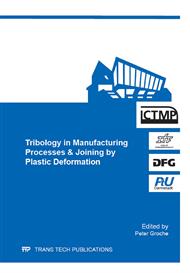[1]
J. A. Schey, Tribology in Metalworking: Friction, Lubrication and Wear, Asm Intl, Metals Park, Ohio, (1983).
Google Scholar
[2]
R. Ahmed, M. P. F. Sutcliffe, Identification of surface features on cold-rolled stainless steel strip, Wear 244 (1-2) (2000) 60–70.
DOI: 10.1016/s0043-1648(00)00442-7
Google Scholar
[3]
J. G. Lenard, Metal Forming Science and Practice: A State-of-the-Art Volume in Honour of Professor J.A. Schey's 80th Birthday, elsevier science, (2002).
Google Scholar
[4]
J. I. Bech, N. Bay, M. Eriksen, Entrapment and escape of liquid lubricant in metal forming, Wear 232 (2) (1999) 134–139.
DOI: 10.1016/s0043-1648(99)00136-2
Google Scholar
[5]
I. Shimizu, J. L. Andreasen, J. I. Bech, N. Bay, Influence of Workpiece Surface Topography on the Mechanisms of Liquid Lubrication in Strip Drawing, Journal of Tribology 123 (2) (2001) 290.
DOI: 10.1115/1.1308017
Google Scholar
[6]
C. Sorensen, B. J, J. Andreasen, N. Bay, U. Engel, T. Neudecker, A Basic Study of the Influence of Surface Topography on Mechanisms of Liquid Lubrication in Metal Forming, CIRP Annals - Manufacturing Technology 48 (1) (1999) 203–208.
DOI: 10.1016/s0007-8506(07)63166-7
Google Scholar
[7]
A. Wihlborg, Steel sheet surface topography and its influence on friction in a bending under tension friction test, International Journal of Machine Tools and Manufacture 41 (13-14) (2001) 1953–(1959).
DOI: 10.1016/s0890-6955(01)00060-8
Google Scholar
[8]
A. Stephany, J. P. Ponthot, Improvement of an Iterative and Staggered Approach for a Model of Mixed-Lubrication in Cold Rolling, AIP Conference Proceedings 712 (1) (2004) 406–411.
DOI: 10.1063/1.1766558
Google Scholar
[9]
M. P. F. Sutcliffe, H. R. Le, R. Ahmed, Modeling of Micro-Pit Evolution in Rolling or Strip-Drawing, Journal of Tribology 123 (4) (2001) 791.
DOI: 10.1115/1.1352741
Google Scholar
[10]
P. Montmitonnet, La plasto-hydrodynamique (PHD) application de la théeorie de la lubrification aux procédés de mise en forme des métaux, Comptes Rendus de l'Académie des Sciences - Series IV - Physics 2 (5) (2001) 729–737.
DOI: 10.1016/s1296-2147(01)01215-x
Google Scholar
[11]
M. Saniei, M. Salimi, Development of a mixed film lubrication model in cold rolling, Journal of Materials Processing Technology 177 (1-3) (2006) 575–581.
DOI: 10.1016/j.jmatprotec.2006.04.049
Google Scholar
[12]
H. Saito, M. Masuda, Modeling of blast process using indenting method, Precision engineering 28 (October 2003) (2004) 369–377.
DOI: 10.1016/j.precisioneng.2003.11.006
Google Scholar
[13]
E. d. S. Neto, P. D. Periæ, P. D. Owen, Computational Methods for Plasticity: Theory and Applications, Wiley, (2009).
Google Scholar
[14]
Abaqus, Theory Manual (2008).
Google Scholar
[15]
G. Stachowiak, A. Batchelor, Engineering tribology, Butterworth-Heinemann, (2005).
Google Scholar
[16]
A. K. Mohanty, Fluid Mechanics, PHI Learning Pvt. Ltd., (2004).
Google Scholar
[17]
S. Kucharski, G. Starzyski, A. Bartoszewicz, Prediction of surface roughness in metal forming with liquid lubricant, Tribology International 43 (1-2) (2010) 29–39.
DOI: 10.1016/j.triboint.2009.04.028
Google Scholar
[18]
S. Huart, M. Dubar, R. Deltombe, A. Dubois, L. Dubar, Asperity deformation, lubricant trapping and iron fines formation mechanism in cold rolling processes, Wear 257 (5-6) (2004) 471–480.
DOI: 10.1016/j.wear.2004.01.012
Google Scholar
[19]
X. Roizard, F. Raharijaona, Influence of sliding direction and sliding speed on the micro- hydrodynamic lubrication component of aluminium mill-finish sheets, Tribology International 32 (1999) (2000) 739–747.
DOI: 10.1016/s0301-679x(00)00008-6
Google Scholar
[20]
C. Hubert,N. Bay, P. Christiansen, R. Deltombe, L. Dubar, M. Dubar, and A Dubois. Numerical Simulation of Lubrication Mechanisms at Mesoscopic Scale. CIRP Annals - Manufacturing Technology 61 (2012) 271–274.
DOI: 10.1016/j.cirp.2012.03.126
Google Scholar


